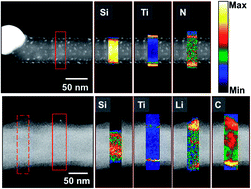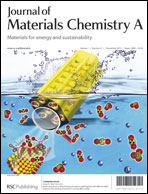Silicon nanowire lithium-ion battery anodes with ALD deposited TiN coatings demonstrate a major improvement in cycling performance†
Abstract
We demonstrate that nanometer-scale TiN coatings deposited by atomic layer deposition (ALD), and to a lesser extent by magnetron sputtering, will significantly improve the electrochemical cycling performance of silicon nanowire lithium-ion battery (LIB) anodes. A 5 nm thick ALD coating resulted in optimum cycling capacity retention (55% vs. 30% for the bare nanowire baseline, after 100 cycles) and coulombic efficiency (98% vs. 95%, at 50 cycles), also more than doubling the high rate capacity retention (e.g. 740 mA h g−1vs. 330 mA h g−1, at 5 C). We employed a variety of advanced analytical techniques such as electron energy loss spectroscopy (EELS), focused ion beam analysis (FIB) and X-ray photoelectron spectroscopy (XPS) to elucidate the origin of these effects. The conformal 5 nm TiN remains sufficiently intact to limit the growth of the solid electrolyte interphase (SEI), which in turn both improves the overall coulombic efficiency and reduces the life-ending delamination of the nanowire assemblies from the underlying current collector. Our findings should provide a broadly applicable coating design methodology that will improve the performance of any nanostructured LIB anodes where SEI growth is detrimental.


 Please wait while we load your content...
Please wait while we load your content...